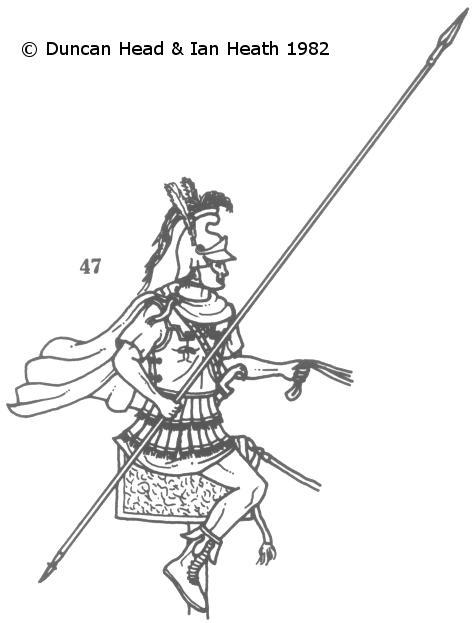
HELLENISTIC XYSTOPHOROS CAVALRYMAN
An extract from Armies of the Macedonian and Punic Warsby Duncan Head, illustrated by Ian Heath
47. HELLENISTIC XYSTOPHOROS CAVALRYMAN

Some Hellenistic cavalry retained the xyston, but those who did so do not seem to have adopted shields, though certainty is difficult. This figure is based on a Roman coin celebrating the defeat of Macedon in 168. He may conceivably be a Macedonian, but as he is shown charging triumphantly rather than defeated and dispirited he is more likely a Roman ally, depicted to celebrate their assistance. Cavalry from several Greek states helped Rome during this war, but the most important contingent came from Rome’s faithful ally Pergamon, and this figure is most likely a Pergamene. Equipment is basically that of figure 30, but the Boiotian helmet became less common in the 3rd century, and Macedonian types developed from the Thracian became standard. This man’s crest and feathers may indicate that he comes from a bodyguard unit. Clothing colours would still usually be those noted under figure 30. Seleucid and Ptolemaic art occasionally shows long tunic sleeves.
Apart from Pergamenes, cavalry similarly armed seem to have included Ptolemaic, early Seleucid, later Achaian and possibly Athenian troops. Several contemporary illustrations show Ptolemaic cavalry with long xysta and no shields, the latest dating about 200 BC, some time after shields had been introduced elsewhere. Seleucid cavalry are called xystophoroi by Polybios and Plutarch, and a relief of a shieldless xystophoros, of uncertain date, comes from Ephesos. In general, illustrations of Hellenistic cavalry with the long spear are quite numerous, and so are illustrations of cavalry with shields; it is not likely to be coincidence that the two are never seen together.
In Greece proper, Plutarch describes Philopoimen using a xyston, so he may have re-armed the Achaian cavalry, as he did their infantry, though he may perhaps have been expressing personal preference alone. Polybios, once general of the Achaian League’s cavalry, regards large round shields as standard Greek cavalry gear, but this need not mean that the Achaian xystophoroi used them. Finally, there is a relief of Hellenistic date from Athens showing a cavalryman in Boiotian helmet thrusting underarm with a spear, perhaps a xyston (though the old shorter cavalry spear of figure 27 is possible) so the Athenians too may have become xystophoroi.